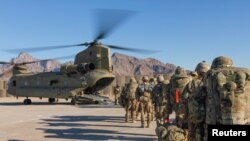Days after U.S. President Joe Biden announced his decision to withdraw from Afghanistan and end the United States' longest-running war, military planners, despite having had months to deliberate, are still working on how to make that happen.
The Defense Department on Friday declined to share details about the impending pullout of some 2,500 to 3,500 troops from Afghanistan, saying that preliminary plans are being updated and that the final so-called tasking orders will come "very, very soon." Officials also left open the possibility that more troops could be sent in, on a temporary basis, to help ensure a safe and orderly withdrawal.
"We'll know more as we get closer, but that would not be out of the realm of the possible," press secretary John Kirby told reporters Friday, in his first briefing at the Pentagon since the announcement.
"I can't speak today with exactly what that would look like," Kirby added. "It's logical to assume that you may need some logistics help, maybe some engineering help. You may have to add some force protection capabilities."
Biden announced Wednesday that the U.S. will begin its drawdown from Afghanistan on May 1 — the date by which the withdrawal was to be completed under the terms of a deal signed last year between the administration of former U.S. President Donald Trump and the Taliban.
Under the new time frame, all U.S. troops, as well as some 7,000 NATO forces, will leave the country by September 11, the 20th anniversary of the deadly terror attacks on New York's World Trade Center and the Pentagon, which were planned on Afghan soil.
In a statement Wednesday, the Taliban demanded the departure of all foreign forces on the date specified in last year's Doha Agreement.
Spokesperson Zabihullah Mujahid further threatened to retaliate, saying on Twitter, "If the agreement is breached and foreign forces fail to exit our country on the specified date, problems will certainly be compounded and those (who) failed to comply with the agreement will be held liable."
The Pentagon on Friday acknowledged the danger and responded with a warning of its own.
"We've seen their threats, and it would be imprudent for us not to take those threats seriously," Kirby said. "It would also be imprudent for the Taliban to not take seriously what the president and what [Defense] Secretary [Lloyd] Austin both made clear, that any attack on our drawdown, on our forces or our allies and partners as they draw down, will be met very forcefully."
Kirby also insisted that even though American forces will be leaving, "it doesn't mean that we're walking away from our Afghan partners."
U.S. officials have promised to continue paying the salaries of Afghan security force members and to financially support the nascent Afghan air force. And Kirby said that, moving forward, the U.S. will continue to support the Afghan military much the same way it supports other allies with which it has bilateral relationships.
Afghan leaders have said they respect the U.S. decision to withdraw its troops and have also expressed confidence in Afghan forces to operate without a U.S. military presence.
"Afghanistan's proud security and defense forces are fully capable of defending its people and country, which they have been doing all along, and for which the Afghan nation will forever remain grateful," President Ashraf Ghani tweeted Wednesday.
Still, concerns persist that Afghan forces will eventually collapse without the U.S. and NATO presence.
"If the goal of our reconstruction effort was to build a strong, stable, self-reliant Afghan state that could protect our national security interests as well Afghanistan's, it is a mission yet to be accomplished and may turn out to be a bridge too far," John Sopko, the U.S. special inspector general for Afghanistan reconstruction, warned last month.
In particular, Sopko warned, that for all the gains made by Afghanistan's security forces, they still are unable to function without the help of U.S. defense contractors.
"The Afghan government relies heavily on these foreign contractors and trainers to function," Sopko said at the time. "No Afghan airframe can be sustained as combat effective for more than a few months in the absence of contractor support."
According to the Pentagon, it still has about 16,800 contractors, including more than 6,000 U.S. citizens, in Afghanistan, more than one-third of whom work on maintenance and logistics.
Most of them, though, are expected to leave with the troops.
"There are preliminary plans that are being revised to extract contractors with military personnel," Kirby said Friday. "Clearly the goal is to get all our personnel out, and I suspect that contractors will be part of that."
"Whether there'll still be a need for some contractor support, I just don't know," he added. "We don't have that level of detail right now."
